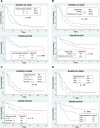Impact of Baseline Nutrition and Exercise Status on Toxicity and Outcomes in Phase I and II Oncology Clinical Trial Participants
- PMID: 32043776
- PMCID: PMC7011642
- DOI: 10.1634/theoncologist.2019-0289
Impact of Baseline Nutrition and Exercise Status on Toxicity and Outcomes in Phase I and II Oncology Clinical Trial Participants
Abstract
Background: Malnutrition and physical inactivity are common in patients with advanced cancer and are associated with poor outcomes. There are increasing data that altered body composition is related to the pharmacokinetic properties of cancer therapies. These adverse conditions may impact outcomes in early-phase oncology clinical trials.
Materials and methods: We aimed to understand the relationships between baseline nutrition and exercise status with important trial endpoints including treatment-related toxicity and survival. Baseline assessments of nutrition and exercise status were conducted in patients prior to initiation of phase I and II oncology clinical trials. Patients were followed prospectively for the onset of adverse events. Tumor response and survival data were also obtained. Fisher's exact test and chi-square analysis were used to determine statistical significance. Kaplan-Meier curves were used to compare patient duration on study and survival.
Results: One hundred patients were recruited, of whom 87 were initiating a phase I trial. Sixty percent were initiating trials studying immunotherapeutic agents. Critical malnutrition was found in 39% of patients, and 52% were sedentary. Patients who were malnourished had significantly increased rates of grade ≥ 3 toxicity (p = .001), hospitalizations (p = .001), and inferior disease control rate (p = .019). Six-month overall survival was significantly reduced in malnourished patients versus nonmalnourished patients (47% vs. 84%; p = .0003), as was median duration on study (48 days vs. 105 days; p = .047). Being sedentary at baseline was associated with decreased duration on study (57 days vs. 105 days; p = .019).
Conclusion: Malnutrition and sedentary lifestyle are highly prevalent in patients enrolling on early-phase oncology clinical trials and are associated with poor outcomes. The quality of data from these studies may be compromised as a result of these pre-existing conditions.
Implications for practice: Phase I and II trials are critical steps in the development of effective cancer therapeutics, yet only a small percentage of agents are ultimately approved for human cancer care. Despite increasing awareness of the interactions between malnutrition, sarcopenia, and treatment-related outcomes such as toxicity and response, these factors are not commonly incorporated into therapeutic decision making at the time of clinical trial consideration. Nutritional status and physical performance may be key biomarkers of mechanisms mediating treatment-related toxicity, dose modifications, risk of hospitalizations, and success of novel agents. This study advocates that a baseline nutritional assessment and early nutritional support may improve tolerability and response to experimental therapies.
Keywords: Cachexia; Exercise; Malnutrition; Outcomes; Toxicity.
© AlphaMed Press 2019.
Conflict of interest statement
Figures

Similar articles
-
Cancer-associated malnutrition, cachexia and sarcopenia: the skeleton in the hospital closet 40 years later.Proc Nutr Soc. 2016 May;75(2):199-211. doi: 10.1017/S002966511500419X. Epub 2016 Jan 20. Proc Nutr Soc. 2016. PMID: 26786393 Review.
-
Computed tomography diagnosed cachexia and sarcopenia in 725 oncology patients: is nutritional screening capturing hidden malnutrition?J Cachexia Sarcopenia Muscle. 2018 Apr;9(2):295-305. doi: 10.1002/jcsm.12258. Epub 2017 Dec 21. J Cachexia Sarcopenia Muscle. 2018. PMID: 29271097 Free PMC article.
-
Malnutrition prevalence in cancer patients in Belgium: The ONCOCARE study.Support Care Cancer. 2024 Jan 27;32(2):135. doi: 10.1007/s00520-024-08324-6. Support Care Cancer. 2024. PMID: 38280135 Free PMC article.
-
Malnutrition, sarcopenia, and cancer cachexia in gynecologic cancer.Gynecol Oncol. 2023 Aug;175:142-155. doi: 10.1016/j.ygyno.2023.06.015. Epub 2023 Jun 27. Gynecol Oncol. 2023. PMID: 37385068 Review.
-
The Spectrum of Malnutrition/Cachexia/Sarcopenia in Oncology According to Different Cancer Types and Settings: A Narrative Review.Nutrients. 2021 Jun 9;13(6):1980. doi: 10.3390/nu13061980. Nutrients. 2021. PMID: 34207529 Free PMC article. Review.
Cited by
-
Significant impact of cachexia index on the outcomes after hepatic resection for colorectal liver metastases.Ann Gastroenterol Surg. 2022 May 11;6(6):804-812. doi: 10.1002/ags3.12578. eCollection 2022 Nov. Ann Gastroenterol Surg. 2022. PMID: 36338593 Free PMC article.
-
Comparison of surgical complications after curative surgery in patients with oral cavity squamous cell carcinoma and sarcopenia.J Cachexia Sarcopenia Muscle. 2023 Feb;14(1):576-584. doi: 10.1002/jcsm.13162. Epub 2022 Dec 23. J Cachexia Sarcopenia Muscle. 2023. PMID: 36562311 Free PMC article.
-
Immunoprotecting Effects of Exercise Program against Ovarian Cancer: A Single-Blind, Randomized Controlled Trial.Cancers (Basel). 2022 Jun 5;14(11):2808. doi: 10.3390/cancers14112808. Cancers (Basel). 2022. PMID: 35681788 Free PMC article.
-
Effect of Pre-Existent Sarcopenia on Oncological Outcome of Advanced Thyroid Cancer Patients Treated with Tyrosine Kinase Inhibitors.Cancers (Basel). 2022 Sep 21;14(19):4569. doi: 10.3390/cancers14194569. Cancers (Basel). 2022. PMID: 36230491 Free PMC article.
-
Food Insecurity and Dietary Quality in African American Patients with Gastrointestinal Cancers: An Exploratory Study.Nutrients. 2024 Sep 11;16(18):3057. doi: 10.3390/nu16183057. Nutrients. 2024. PMID: 39339658 Free PMC article.
References
-
- Pond GR, Siu LL, Moore M et al. Nomograms to predict serious adverse events in phase II clinical trials of molecularly targeted agents. J Clin Oncol 2008;26:1324–1330. - PubMed
-
- Laviano A, Meguid MM, Rossi‐Fanelli F. Cancer anorexia: Clinical implications, pathogenesis, and therapeutic strategies. Lancet Oncol 2003;4:686–694. - PubMed
-
- Fearon K, Strasser F, Anker SD et al. Definition and classification of cancer cachexia: An international consensus. Lancet Oncol 2011;12:489–495. - PubMed
Publication types
MeSH terms
Grants and funding
LinkOut - more resources
Full Text Sources
Medical

